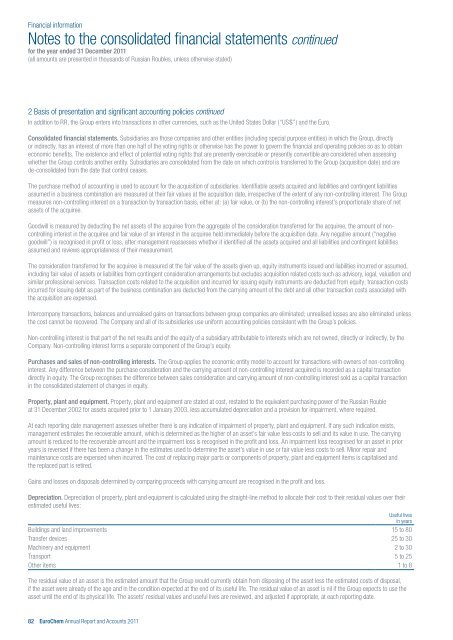You also want an ePaper? Increase the reach of your titles
YUMPU automatically turns print PDFs into web optimized ePapers that Google loves.
Financial information<br />
Notes to the consolidated financial statements continued<br />
for the year ended 31 December <strong>2011</strong><br />
(all amounts are presented in thousands of Russian Roubles, unless otherwise stated)<br />
2 Basis of presentation and significant accounting policies continued<br />
In addition to RR, the Group enters into transactions in other currencies, such as the United States Dollar (“US$”) and the Euro.<br />
Consolidated financial statements. Subsidiaries are those companies and other entities (including special purpose entities) in which the Group, directly<br />
or indirectly, has an interest of more than one half of the voting rights or otherwise has the power to govern the financial and operating policies so as to obtain<br />
economic benefits. The existence and effect of potential voting rights that are presently exercisable or presently convertible are considered when assessing<br />
whether the Group controls another entity. Subsidiaries are consolidated from the date on which control is transferred to the Group (acquisition date) and are<br />
de-consolidated from the date that control ceases.<br />
The purchase method of accounting is used to account for the acquisition of subsidiaries. Identifiable assets acquired and liabilities and contingent liabilities<br />
assumed in a business combination are measured at their fair values at the acquisition date, irrespective of the extent of any non-controlling interest. The Group<br />
measures non-controlling interest on a transaction by transaction basis, either at: (a) fair value, or (b) the non-controlling interest’s proportionate share of net<br />
assets of the acquiree.<br />
Goodwill is measured by deducting the net assets of the acquiree from the aggregate of the consideration transferred for the acquiree, the amount of noncontrolling<br />
interest in the acquiree and fair value of an interest in the acquiree held immediately before the acquisition date. Any negative amount (“negative<br />
goodwill”) is recognised in profit or loss, after management reassesses whether it identified all the assets acquired and all liabilities and contingent liabilities<br />
assumed and reviews appropriateness of their measurement.<br />
The consideration transferred for the acquiree is measured at the fair value of the assets given up, equity instruments issued and liabilities incurred or assumed,<br />
including fair value of assets or liabilities from contingent consideration arrangements but excludes acquisition related costs such as advisory, legal, valuation and<br />
similar professional services. Transaction costs related to the acquisition and incurred for issuing equity instruments are deducted from equity; transaction costs<br />
incurred for issuing debt as part of the business combination are deducted from the carrying amount of the debt and all other transaction costs associated with<br />
the acquisition are expensed.<br />
Intercompany transactions, balances and unrealised gains on transactions between group companies are eliminated; unrealised losses are also eliminated unless<br />
the cost cannot be recovered. The Company and all of its subsidiaries use uniform accounting policies consistent with the Group’s policies.<br />
Non-controlling interest is that part of the net results and of the equity of a subsidiary attributable to interests which are not owned, directly or indirectly, by the<br />
Company. Non-controlling interest forms a separate component of the Group’s equity.<br />
Purchases and sales of non-controlling interests. The Group applies the economic entity model to account for transactions with owners of non-controlling<br />
interest. Any difference between the purchase consideration and the carrying amount of non-controlling interest acquired is recorded as a capital transaction<br />
directly in equity. The Group recognises the difference between sales consideration and carrying amount of non-controlling interest sold as a capital transaction<br />
in the consolidated statement of changes in equity.<br />
Property, plant and equipment. Property, plant and equipment are stated at cost, restated to the equivalent purchasing power of the Russian Rouble<br />
at 31 December 2002 for assets acquired prior to 1 January 2003, less accumulated depreciation and a provision for impairment, where required.<br />
At each <strong>report</strong>ing date management assesses whether there is any indication of impairment of property, plant and equipment. If any such indication exists,<br />
management estimates the recoverable amount, which is determined as the higher of an asset’s fair value less costs to sell and its value in use. The carrying<br />
amount is reduced to the recoverable amount and the impairment loss is recognised in the profit and loss. An impairment loss recognised for an asset in prior<br />
years is reversed if there has been a change in the estimates used to determine the asset’s value in use or fair value less costs to sell. Minor repair and<br />
maintenance costs are expensed when incurred. The cost of replacing major parts or components of property, plant and equipment items is capitalised and<br />
the replaced part is retired.<br />
Gains and losses on disposals determined by comparing proceeds with carrying amount are recognised in the profit and loss.<br />
Depreciation. Depreciation of property, plant and equipment is calculated using the straight-line method to allocate their cost to their residual values over their<br />
estimated useful lives:<br />
Useful lives<br />
in years<br />
Buildings and land improvements 15 to 80<br />
Transfer devices 25 to 30<br />
Machinery and equipment 2 to 30<br />
Transport 5 to 25<br />
Other items 1 to 8<br />
The residual value of an asset is the estimated amount that the Group would currently obtain from disposing of the asset less the estimated costs of disposal,<br />
if the asset were already of the age and in the condition expected at the end of its useful life. The residual value of an asset is nil if the Group expects to use the<br />
asset until the end of its physical life. The assets’ residual values and useful lives are reviewed, and adjusted if appropriate, at each <strong>report</strong>ing date.<br />
82 EuroChem Annual Report and Accounts <strong>2011</strong>



